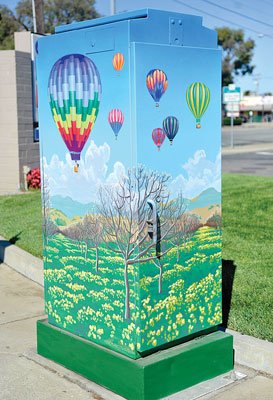After a successful pilot in June, the city is on track to
embellish the next round of otherwise drab traffic signal boxes
with custom, Gilroy-themed murals that enliven intersections and
discourage tagging.
After a successful pilot in June, the city is on track to embellish the next round of otherwise drab traffic signal boxes with custom, Gilroy-themed murals that enliven intersections and discourage tagging.
“We’re very confident with the project,” said Rachel Munoz, community service officer for the Gilroy Police Department. “People are so excited about the Adopt-a-Box Mural program.”
Instead of reacting with complacency to “blighted traffic signal boxes” that attract graffiti, the program will infuse downtown and surrounding areas with aesthetic pops of color that are “not only eye-pleasing, but really refreshing” to look at, Munoz said. The program is in place to move forward with the next six to eight units, which are slated to receive a colorful facelift from local artists in May.
The first four boxes already coated in Gilroy-themed murals – such as garlic bulb hot air balloons drifting in a blue sky, rolling vineyards, local flora and scenes from the Gilroy Gardens theme park – are located at Monterey and Farrell, Monterey and Third, Monterey and 10th, and Princevalle and 10th streets. These were the four most frequently tagged boxes in Gilroy, according to Munoz, who said ensuing boxes slated for painting will be given priority based on vulnerability to tagging.
The city will have to raise $6,400 to get the ball rolling with the next phase of the program targeting an additional eight boxes. Sponsors can opt to adopt an entire box for $800, which covers commission for the artist, prepping the box to become a canvas and protecting the final work with an anti-graffiti sealant. Full sponsorships credits the name of the organization, business or individual sponsor. Donating $200 buys a donor’s name painted on the box alongside three others.
“The reason we want people to participate with the financial support is so they have ownership,” added Munoz. “Not for publicity, but for ownership.”
The city hired Santa Cruz artist Bruce Harman using funds remaining in the graffiti paint contractor account for 2011. Selected to spearhead Gilroy’s own pilot program, he’s a freelance artist of 27 years who has painted several traffic traffic signal boxes in Capitola and Santa Cruz.
The next crop of paintings, however, will utilize local talent.
Since receiving its makeover, the painted traffic signal box on the corner of Farrell and Monterey streets has been marked up on several occasions. A special protective coating, however, allows Gilroy paint contractor Tim Collins to remove the graffiti and restore the artwork. Collins has a contract with the city, and will be responsible for the ongoing maintenance and restoration of the murals, should any be vandalized in the future.
The boxes house electronic equipment called signal controllers, which regulate the timing of different signal phases, according to David Stubchaer, senior civil engineer for the City of Gilroy.
Munoz said the three other traffic signal boxes have been untouched.
She added that city staff is still in the process of identifying all city-owned boxes that will be available for adoption. Sponsors with a location preference will be able to work with the city in terms of selection, she said.
Sponsoring a box, Munoz added, will hopefully boost downtown pride among local businesses, prompting them to become “the eyes and ears” when it comes to alerting the city about vandalism.
She said several sponsors have begun to line up, including Christopher Ranch – the first business to send in a full donation as of Sept. 20, Munoz noted, along with South County Housing, Gilroy Rotary, Councilman Dion Bracco with Bracco’s Towing & Transport and the Gilroy Exchange Club.
“We’re having our initial sketches done as we speak,” said Erwin Boggs, president of the Gilroy Exchange Club who said their group is leaning toward an Americanism theme.
He said the organization, which helps sponsor the GPD’s Gang Task Force, wants to help “keep our city looking the way it should.”
The Exchange Club is looking to adopt a box near the intersection of Third Street and Wren Avenue, which Boggs observed may not have been sponsored since it’s away from downtown.
Boggs said he hopes other businesses will “step up and take ownership of the area they are in.”
Encouraged by budding interest from supporters, Munoz said she would like to see Gilroy Chamber of Commerce and Downtown Business Association consider sponsorship.
Once the money is raised, the city will issue an open call to local artists. Candidates will need to submit a sampling of artwork, which will allow sponsors to select from a pool of ideas. Themes must somehow tie in to all things Gilroy, said Munoz.
Her list of amassing suggestions include Herbie (famed mascot of the Gilroy Garlic Festival), a collage of plants and produce specific to the region, Gilroy’s iconic rodeo cowboy Casey Tibbs, Old City Hall (now Lizarran Restaurant), a summer landscape with rolling yellow hills, wildflowers and birds, Porcella’s Music Store, a historical collage and a re-creation of the Gilroy Garlic Festival’s winning entry from the poster contest.
“Those are some ideas that have surfaced,” said Munoz. “We want to continue that momentum and support peoples’ ideas. This is their community.”
Munoz credits volunteers with the Wipeout Watch Committee, a group dedicated to graffiti prevention and abatement, as instrumental with the traffic signal box mural project.
“We’re starting to see a bit of a drop off in tagging right now,” said Russ Fruchey, who has been volunteering for two years with his wife, Linda. Seeing the mural concept sprout from brainchild, to work-in-progress to pending reality is “amazing,” he said.
GPD Chief Denise Turner is extremely pleased with the endeavor, which so far has received “great feedback.”
After fundraising and a roundup of chosen artists, mural options will be screened for approval by the Arts and Culture Commission, the Public Art Committee and City Council. The approval process will likely take six to eight weeks, and, weather permitting, will segue to the production of more murals in May.
Following this will hopefully come a third phase of six to eight more painted boxes in 2013.
“We’ll do in a progression,” Munoz explained. “Right now we’re identifying the most vulnerable traffic signal boxes. We have a rhyme and a reason.”













